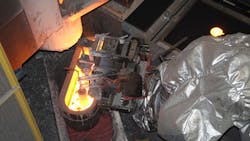When GF Automotive made the decision to rebuild its ductile iron foundry in Mettman, Germany, about five years ago, robotics were a critical element of its vision for increased efficiency. The plant was already more than a century old at the time, so the estimated $46.5-million project centering on a robotic pouring and handling was a that much more novel.
The Mettmann foundry produces up to 200,000 metric tons/year of ductile iron automotive and commercial vehicle parts, including longitudinal bearings, steering knuckles, suspension arms, camshafts, rear-axle casings, and wheel hubs. Ductile iron melting is done in a 90-mt channel induction furnace, which supplies what GF Automotive labeled the Aeration Molding Robotpouring (AMR) production line that yields up to 60,000 metric tons/year of “exceptionally fine-featured, and thus lightweight,” according to the operator.
The line has two robots pouring ductile iron, reducing the labor requirements, and also sets “a benchmark in terms of energy efficiency GF Automotive stated. A built-in heat-recovery system converts waste heat to warm the plant, and state-of-the-art electro motors are used to cut energy consumption by over 40%.
The foundry knew its vision for high-volume automation demanded a technical solution for pouring molten iron into molds with the greatest possible flexibility. Typically, automated pouring is performed by systems that can only fill a sand mold at a single point: Since pouring is stationary, at a fixed position, “flexible” casting is not possible.
Kuka Robotics devised a system with two KR 1000 Titan robots for casting the molten iron, allowing the foundry to gain the flexibility to maximize the mold area for greater pouring efficiency. The two robots work in parallel in a solution developed by robotics system integrator Robotec Engineering GmbH. The pouring system no longer dictates where the mold can be positioned.
A heat-resistant shroud protects them against the foundry workplace conditions. Mounted on the robot flange is a casting ladle filled with 1,400°C iron. A load cell is installed between the casting ladle and the robot flange, to weigh the quantity of molten iron, and ensure the precise volume of iron required to make up the correct portion for the next casting cycle. Only the optimal volume of metal is measured into the casting ladle – which ensures waste is minimal.
The flexibility of the six-axis Kuka robots means that iron can be poured into the mold at any point. Once the molds are filled and the castings are formed and cooled to room temperature, the parts are cleaned, inspected, and prepared for shipment.
Kuka noted that if there are malfunctions or lengthy downtimes in the process, Robotec has developed a method for avoiding metal being held, possibly to solidify in the ladle. The two robots are able to return process iron to the casting furnace. (This contributes to energy savings and logistics costs, but also limits the risk of excess CO2 emissions, Kuka noted.)
Another innovation is fully automatic casting ladle changing – the robot can put down the used casting ladle and pick up a new one, just like a robot gripper change, according to Kuka. The robots also are available for various setup tasks on the pouring aisle.
Kuka describes the KR 1000 titan F as a compact design with comparatively low weight, 4,700 kg. It can be integrated into complete systems without requiring special foundations, and it can manage very high payloads of about 950 kg. Along with lifting very heavy loads, it is capable of precise positioning: It easily covers distances up to 6.5 m, without over-occupying valuable workspace.
About the Author
Robert Brooks
Content Director
Robert Brooks has been a business-to-business reporter, writer, editor, and columnist for more than 20 years, specializing in the primary metal and basic manufacturing industries. His work has covered a wide range of topics, including process technology, resource development, material selection, product design, workforce development, and industrial market strategies, among others.
